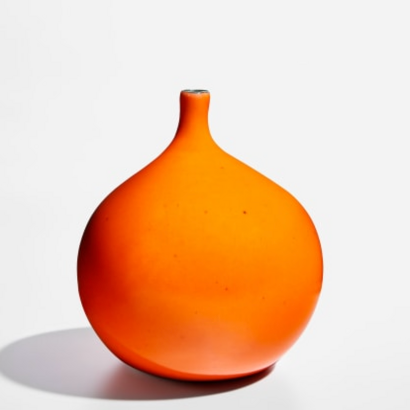Georges Jouve
During the Second World War, captured by the Germans, he escaped to the Drôme pottery village of Dieulefit, where he immersed himself in the art of ceramics. By 1941, he was creating his first pieces, inspired by nature and the sacred arts, and already displaying a decorative dimension.
In 1945, Georges Jouve and his family returned to Paris, where he set up his workshop on rue de la Tombe Issoire for 9 years before moving to Aix-en-Provence in 1954. He works with the black enamel characteristic of his ceramics, offering a deep, slightly satiny color, creating the illusion of metallic pieces, while continuing to embellish theaters.
Exhibitions: Georges Jouve was invited to several exhibitions on his return to Paris, including "La Céramique Contemporaine" in Birmingham in 1947, where he won a silver medal for a wall covering at the Exposition de l'Urbanisme in Paris the same year. Solicited by the French Ministries of Education and Foreign Affairs, he exhibited his work around the world, from Rio de Janeiro (1946) to Rome (1950), via Toronto (1949) and Cairo (1949). In 1949, he became a member of the Salon des Artistes Décorateurs.
Georges Jouve's characteristic style: Georges Jouve revolutionized traditional pottery techniques by emphasizing the density and thickness of the material, adopting an approach close to sculpture and modeling. A pioneer of contemporary ceramics, he explored brightly colored glazes, creating imposing, uncluttered pieces from 1950 onwards, emphasizing sculpture rather than mere decoration.
Emblematic works by Georges Jouve:
Georges Jouve bottles
Red Jouve vase
Apple" vase
Mermaid-motif Vide-Poche
Lampshade
Coat rack with mirror
Recognizing Georges Jouve's signature
Georges Jouve signs most of his work by inscribing his name "JOUVE" directly into the ceramic, often accompanied by the letter Alpha (or cross). Variations do exist, however.
Value and estimate of Georges Jouve's works
Considered one of the fathers of contemporary ceramics, Georges Jouve's creations, ranging from vases to furniture objects, are highly sought-after by collectors. Prices range from a few hundred to several thousand euros, with exceptional pieces exceeding 40,000 euros. For an accurate estimate, submit your piece to our specialists, as values can vary widely.
How can I have a Georges Jouve work appraised?
Simply fill in our no-obligation online form. Our expert will confirm the authenticity of your piece when it is deposited at our office for auction.
Appraise and sell a Georges Jouve ceramic
Do you own a work by Georges Jouve?
Request a free appraisal via our online form.
Our experts and auctioneers will contact you to provide you with an estimate and advice to optimize the sale at the best price.


